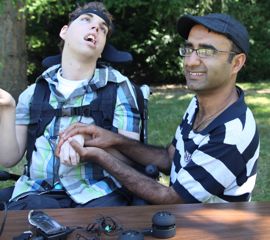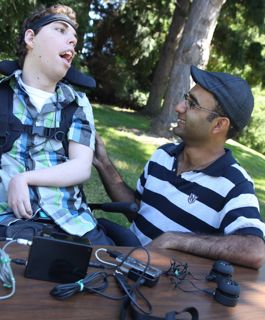EMG Switch with iPod

Combining two popular CanAssist technologies has enabled David Melville to independently control his iPod and enjoy his favourite reggae songs.
David has cerebral palsy and cortical visual impairment, as well as other conditions. He has very limited muscle control, is unable to speak and depends on support workers for everyday tasks.
One of his support workers, Ruth, wanted him to experience independence, so she contacted CanAssist in the hope of finding a way to let David express choices in his life. Because David enjoys music – particularly loud reggae – CanAssist focused its attention on providing David with a way to select his own tunes.
 CanAssist had
already designed an iPod adapter, called the podWiz. This unobtrusive adapter attaches to a standard Apple iPod
and allows people to control their iPod by pressing a single button or switch.
But due to David's inability to move his limbs, he is unable to use a standard
accessibility switch.
CanAssist had
already designed an iPod adapter, called the podWiz. This unobtrusive adapter attaches to a standard Apple iPod
and allows people to control their iPod by pressing a single button or switch.
But due to David's inability to move his limbs, he is unable to use a standard
accessibility switch.
Instead, Sunny Mahajan, CanAssist's technical coordinator, paired the podWiz with another technology designed by CanAssist – the facial electromyography (EMG) switch.
Sunny says that even individuals with very limited muscle movement, such as David, are typically able to control at least some of their facial muscles. For example, when they contract and relax their forehead or jaw muscles, they generate electrical impulses. Surface electrodes located on a headband worn by the user detect these signals and send the information to an attached EMG device.
“By looking up, David produces enough electrical impulses to trigger the EMG switch,” Sunny explains. “It is a slight movement, but the EMG switch is sensitive enough to receive and interpret these movements. When David triggers the EMG switch successfully, the iPod will play music.”
David has had to practice controlling the EMG switch. But this is an important step because once the device is mastered, it will allow David to use devices other than the iPod independently. To encourage him, the podWiz is on training mode, set to play music for 20 seconds after each successful eye raise. In other words, every time David successfully triggers the EMG, he is rewarded by the sound of his music.
“David is such a lovely gentleman to work with and it is so wonderful to see him able to have some control over his environment; to have something that is just his,” says Ina, David's primary caretaker. “He seems very proud to show off his music to everyone.”
David continues to improve and become an expert with the EMG. He has also gained the ability to enjoy his music independently for the first time. As his ability to use EMG technology improves, he will be able to access new realms of independence and freedom.
(This technology was delivered in June 2010.)
Check out additional articles on CanAssist's EMG technology and our iPod project.
